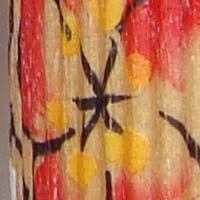Sony Cyber-shot DSC-T77 Review
Review Date: February 27th 2009
Author: Gavin Stoker
Leave a comment about this review
|
Image Quality
All of the sample images in this Review were taken using the 10M JPEG mode, which gives an average image size of around 3.5Mb.
For a happy snappy pocket camera, and one that practically screams 'style over substance' from the outset, the images the Sony Cyber-shot DSC-T77 delivers are better than expected - warm, colourful and with a reasonable level of detail provided - even if the positioning of the lens means it's open to being preyed on by stray digits peeping into shot and also becoming the victim of lens flare. Also prompting a grumble is the occasional exposure problem, suggesting metering isn't that sophisticated, while our white wall test shots reveal that at its widest setting some barrel distortion is present, though when shooting the vast majority of alternative subjects this wouldn't be noticeable. Pixel fringing makes quite a pronounced appearance between areas of high contrast in an image, visible by its purplish hue, while vast expanses of one colour can unduly influence the Sony Cyber-shot DSC-T77's auto white balance. Pictures then, whilst still fairly successful to the untrained eye, do benefit from an application of Auto Levels in Photoshop. In terms of light sensitivity, results up to and including ISO 800 are respectably clear of image noise. Although detail is softening by ISO 1600, grain isn't by any means at ruinous levels. At top whack ISO 3200 the appearance is beginning to take on a water colour-like level of softness, but again, results are still usable. At the end of the day, in reality the Sony Cyber-shot DSC-T77 doesn't seem any more affected by camera shake than does its big brother in the T500, twice the width and just as sturdy, which is a positive note to end on. While its performance is not perfection, it is perfectly adequate for the snapshot market at which it's aimed.
Noise
There are 7 ISO settings available on the Sony Cyber-shot DSC-T77. Here are some 100% crops which show the noise levels for each ISO setting:
ISO 80 (100% Crop) |
ISO 100 (100% Crop) |
 |
 |
ISO 200 (100% Crop) |
ISO 400 (100% Crop) |
 |
 |
ISO 800 (100% Crop) |
ISO 1600 (100% Crop) |
 |
 |
ISO 3200 (100% Crop) |
|
 |
Sharpening
Here are two 100% Crops which have been Saved as Web - Quality 50 in Photoshop. The right-hand image has had some sharpening applied in Photoshop. The out-of-the camera images are a little soft at the default sharpening setting. Unfortunately you can't change the in-camera sharpening level if you don't like the default look, so you will have to edit the images later.
Original
(100% Crop) |
Sharpened (100% Crop) |
 |
 |
 |
 |
Chromatic Aberrations
The Sony Cyber-shot DSC-T77 did suffer from chromatic aberrations during the review, but it was generally very well controlled. Limited purple fringing was mainly present around the edges of objects in high-contrast situations, as shown in the examples below.
Example
1 (100% Crop) |
Example
2 (100% Crop) |
 |
 |
Macro
The Sony Cyber-shot DSC-T77 offers a Macro setting that allows you to focus on a subject that is just 1cm away from the camera when the lens is set to wide-angle. The first image shows how close you can get to the subject (in this case a compact flash card). The second image is a 100% crop.
Macro Shot |
Macro Shot (100% Crop) |
 |
 |
Flash
The flash settings on the Sony Cyber-shot DSC-T77 are Auto, Forced On, Slow Syncro and Forced Off. These shots of a white coloured wall were taken at a distance of 1.5m.
Flash Off - Wide Angle (35mm) |
Auto Flash - Wide Angle (35mm) |
 |
 |
Flash Off - Telephoto (140mm) |
Auto Flash - Telephoto (140mm) |
 |
 |
And here are a couple of portrait shots. The flash caused quite a lot of red-eye. The red-eye reduction mode did not help much, but there is post-capture red-eye removal as well, in playback mode.
Flash On |
Flash On (100% Crop) |
 |
 |
Flash - Red-eye Flash |
Flash - Red-eye Flash (100% Crop) |
 |
 |
Night Shot
The Sony Cyber-shot DSC-T77's maximum shutter speed is 2 seconds in the Twilight scene mode, which isn't good news if you're seriously interested in night photography. The shot below was taken using a shutter speed of 2 seconds, f3.5 at ISO 100. I've included a 100% crop of the image to show what the quality is like.
Night Shot |
Night Shot (100% Crop) |
 |
 |
|
![]() PhotographyBLOG
is a member of the DIWA
organisation. Our test results for the Sony Cyber-shot DSC-T77 have been submitted to DIWA
for comparison with test results for different samples of
the same camera model supplied by other DIWA
member sites.
PhotographyBLOG
is a member of the DIWA
organisation. Our test results for the Sony Cyber-shot DSC-T77 have been submitted to DIWA
for comparison with test results for different samples of
the same camera model supplied by other DIWA
member sites.
